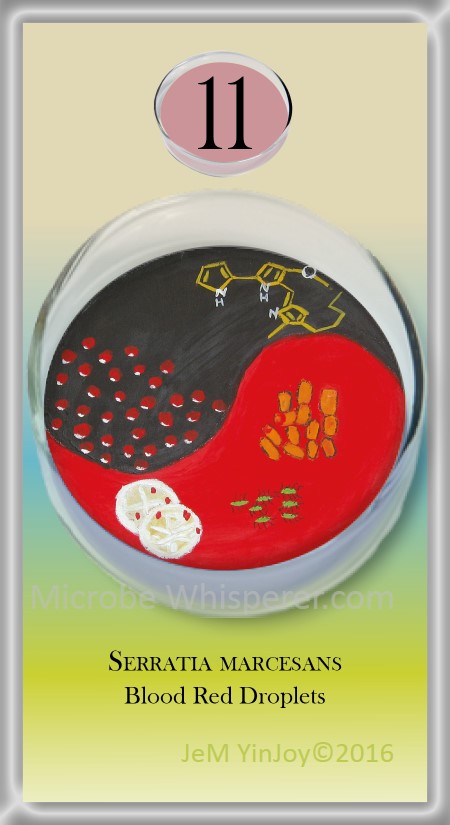
Haiku for S. marcesans
Eucharist Blood
And human sacrifice.
Its pigment
A colored past.
by Dr. JeM YinJoy
How to pronounce Serratia Marcesans.
Serratia Marcesans “Sir-A-shee-ah Mars-cess-Annes”
The Spiritual Significance
Serratia marcesans, and its red colonies reminiscent of blood droplets, has been implicated as the scientific explanation for the miracle of transubstantiation, the conversion of bread and wine to the body and blood of Jesus Christ.
Because S. marcesans is commonly found growing on bread and communion wafers stored in moist places, microbiologists have speculated that this might be the basis for the miracle believed by Catholics, that of transubstantiation. Italian artist Raphael created a work of art called “The Mass at Bolsena”, which shows that during the consecration of the Eucharist, the priest miraculously saw blood dripping from the Host. The story recounts that the priest was skeptical of this miracle, until he was confronted with this red, dripping proof while he said Mass.
S. marcesans was also used in 1906 to learn about bacteria transmission, because its red pigment made it so easy to track. But another experiment in the 1950’s, revealed this microbes ability to cause infections in humans. In that experiment, the US Army filled balloons with Serratia marcesans and exploded them over San Fransisco, and shortly after that, there was an increase in the number of pneumonia and urinary tract infections in the area, including one death. Because of this, Serratia marcesans was classified as human pathogen in the 1960s, which not stop the US government from still running experiments with it on the public until the late 1970s.
There was an increased also in S. marcesans causing infections in hospitals after this type of widespread use by the government.
With its red, blood-like droplets and historical contributions, S. marcesans certainly makes a compelling teacher of human folly.
The actual function of the red pigment is unknown, but given the story of The Mass at Bolsena, who is to say if this is not a divine signal for strengthening the faith of our religious leaders who falter?
The microbe’s red pigment motivated military scientists to expose unsuspecting citizens to a new and fatal disease, giving those in power a wakeup call about the burden of responsibility in using biological warfare.
The red pigment of S. marcesans is used to hide from a host’s immune response and yet, can also be used to cure cancer and possibly other diseases. So it teaches that duality of purpose, a light and a dark side that resonates with teaching of other dual uses for instruments. For example that a knife is an instrument with a light and a dark side, where it can be used to do harm as in killing, or do good as in food preparation to feed the hungry.
The Microbiology
Serratia marcesans was discovered in 1819 by Bartolomeo Bizio in Padua, Italy and was named Serratia in honor of and Italian physicist named Serratia, with marcesans for the species name which in Latin means decay.
Along with its Italian name, it has an Italian notoriety in it has been depicted by Rafael on the walls of the Vatican in a famous painting.
Shape and Size
Serratia marcesans is a motile, short, rod-shaped, Gram-negative, facultative anaerobe bacterium.
Serratia marcesans is motile, with each cell having about 100 – 1000 flagella. Serratia marcesans can also form a biofilm through the secretion of a mucilaginous matrix.
Habitat
Serratia marcesans is everywhere and common in soil, water, plants and animals and in non-potable water. The blood red colonies of this microbe are often found contaminants on otherwise sterile agar in a Petri dish.
Although S. marcesans was discovered to be a pathogenic microorganism, it is only so with people who are immunocompromised. This is why S. marcesans is called an “opportunitistic pathogen” because it finds opportunities to infect those who do not have healthy immune systems and it finds its way to these people through catheters, droplets, saline irrigation solutions, and other solutions that are usually expected to be sterile.
S. marcesans produces its bright red pigmented colonies when grown at room temperature, about 25 deg. C, but stops producing this pigment at temperatures of 35-37 deg. C, making its colonies white. This feature may help it in its opportunistic invasion of a human host, because the red pigment alerts the host body’s immune system, and lack of will allow it to hide under the radar of the infected person’s defenses. The human body temperature of 35-37 deg. Conveniently acts as a thermostat alert for this bacterium, letting it know it is in an environment where losing the pigment is a good idea.









